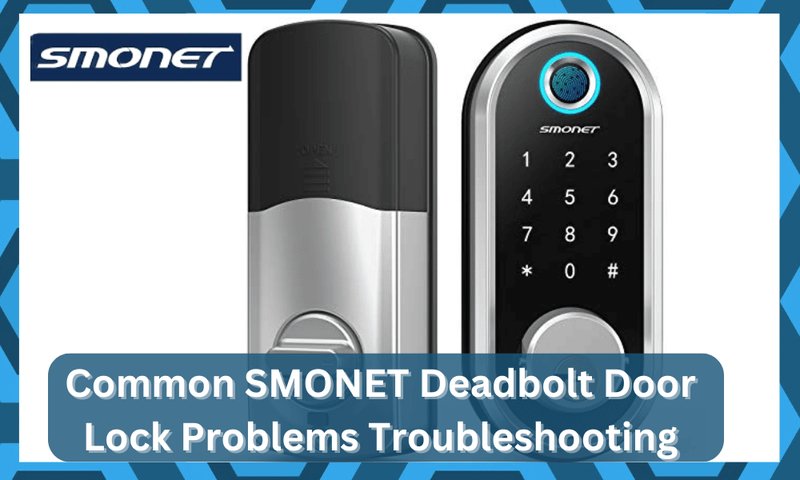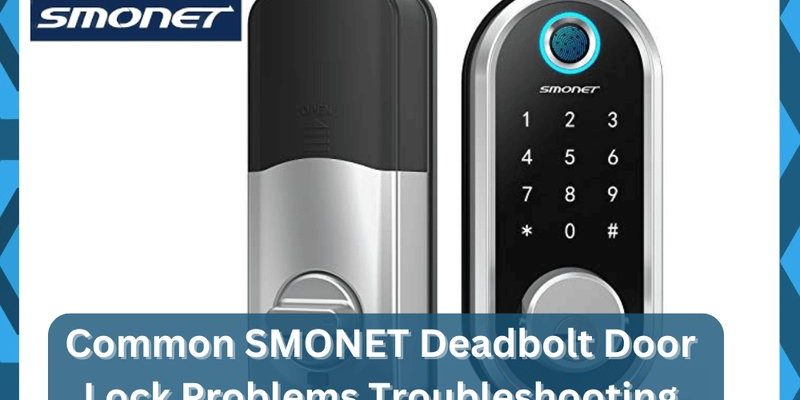
Here’s the thing: smart deadbolts (especially the Wi-Fi or Bluetooth models) are great when they work. But false notifications are surprisingly common—and endlessly annoying. Whether your Schlage remote app keeps buzzing with fake “unlocked” alerts or your Kwikset lock shows up as open when you just shut it, you’re not alone. Let’s break down why it happens, what you can do, and how to stop your smart lock from sending those phantom pings.
What Causes False Notifications in Smart Deadbolts?
You might be wondering: why would your smart deadbolt say the door’s open when it’s absolutely locked and you haven’t touched it? Most of the time, false notifications come down to a handful of overlapping issues. These locks rely on sensors, wireless signals, and sometimes even your home’s inconsistent Wi-Fi—none of which are perfect.
Sensor glitches are one big culprit. Many smart deadbolts, like those from August, use tiny sensors to sense if a door is open, closed, locked, or unlocked. If dust gets into the sensor, or if the door isn’t perfectly aligned, your lock might misread its position and send unnecessary alerts. Sometimes, a strong slam can even rattle the sensors.
Connectivity problems are another beast. If your lock’s Bluetooth connection drops, the app may get confused and assume an event happened. Wi-Fi deadbolts, especially those paired with battery-powered remotes or hubs, can suffer from network hiccups or delays. The result? Your lock’s app might throw out an “unlocked” notification just because it lost contact for a second.
Finally, app or firmware bugs can’t be ignored. Sometimes the code running your lock just misbehaves, sending notifications for events that never happened. That’s why updated firmware and a freshly updated mobile app can make a surprising difference in how reliable your notifications feel.
How Do Smart Deadbolts Detect Door Activity?
Honestly, understanding how these smart locks detect things can help demystify the mess. Most major brands—think Yale, Schlage, August—use a mix of built-in sensors and clever coding to know what’s happening.
Magnetic sensors are common in door locks. There’s usually a small magnet on the door and a sensor in the lock. When the door closes, the magnet lines up with the sensor, telling the lock everything’s shut tight. If the door shifts—maybe you didn’t close it all the way—the sensor can send a confusing signal, causing the app to misreport or trigger unneeded notifications.
Motor and position sensors also play a role. These track if the deadbolt actually turns and locks. But if the gears jam or run low on battery, the lock might think it’s secure when it’s not, or vice versa.
For remote access, Bluetooth and Wi-Fi locks rely on syncing data with your phone or a central hub. If the signal drops or doesn’t sync right, you might see a flurry of notifications as the device tries to catch up. It’s like your lock is “guessing” what’s happening rather than knowing for sure.
Common Reasons Your Smart Deadbolt Sends False Alerts
Knowing the inner workings is great, but what actually causes those alerts to go haywire? There are a handful of everyday issues that pop up across brands—from August and Yale to lesser-known models.
- Weak or dead batteries: When the lock’s battery starts to run low, sensors might not work right or the motor could move too slowly. This can trigger “jammed” or “unlocked” notifications even if nothing’s wrong.
- Wi-Fi or Bluetooth interference: If your home has lots of wireless gadgets—think smart TVs, routers, even microwaves—signals can cross, making your lock lose its connection. When it reconnects, you might get a flood of old or inaccurate alerts.
- Poor door alignment: It sounds basic, but if your door is even a little off-kilter, the sensors may misread whether it’s really open or closed, leading to false notifications.
- App glitches: Sometimes, your smartphone’s lock app doesn’t update in real time, especially if the app is out of date or buggy. Clearing app data, reinstalling the app, or updating it can solve this surprisingly often.
If you’re getting phantom door activity pings or your lock thinks it was unlocked when you know it wasn’t, odds are one of these issues is at play.
Step-by-Step: How to Troubleshoot a Smart Deadbolt Sending False Notifications
Let me walk you through a simple troubleshooting process. Start with the obvious things, then move to more technical fixes if you need to.
- Check and replace batteries: Even if the app says you have battery left, swap them for fresh ones. Low power causes all kinds of weird behavior.
- Check door alignment: Look at where the lock and door meet. If things look off or the door is sagging, adjust the hinges or the plate. Even a few millimeters can make a huge difference in sensor accuracy.
- Clean the sensors: Gently wipe the contact or magnetic sensors with a dry cloth. Dust or grime can block proper detection, especially in humid homes.
- Restart your lock and remote hub: Turn the lock off and on (if possible), or use your app’s “reset” feature. Unplug and replug the Wi-Fi bridge or smart home hub if you’re using one. This can fix minor code glitches.
- Update firmware and apps: Head into the app and check for any software updates—both for the lock and the app on your phone. Updates often patch bugs that cause notification problems.
- Re-pair the lock: If all else fails, remove the lock from your app, reset it, and go through the pairing process again. Just make sure to follow your brand’s instructions so you don’t lose any codes or settings.
If your smart deadbolt is sending false notifications, try each step above, one at a time. Usually, you’ll spot the culprit by halfway down the list.
Examples: How Notification Problems Show Up On Popular Smart Locks
Different brands handle notifications a little differently, but the core issues are annoyingly similar. Take the August Smart Lock, for instance. If your Wi-Fi bridge disconnects, you may get a burst of “door unlocked” and then “door relocked” messages, even if nothing’s happened. It can make you feel like there’s a ghost in the house.
With the Schlage Encode, I’ve seen people complain about “lock jammed” alerts that turn out to be a low battery or a slightly misaligned strike plate. On Kwikset Kevo locks, Bluetooth pairing issues between the lock and your phone’s app can lead to “unlocked by [user]” pings—sometimes at random times of day.
In all these situations, users usually solve the problem by:
- Swapping batteries (even if they aren’t totally dead)
- Updating the lock’s firmware
- Resetting and re-pairing the device to their home Wi-Fi
No matter which smart deadbolt you use, the root causes for false notifications follow these patterns more often than not.
How to Prevent Future False Notifications
Prevention sounds boring, but trust me—it’s a lifesaver with smart locks. The best way to keep your deadbolt from spamming you with fake alerts is to keep everything clean, up-to-date, and properly installed. Here’s how I’d do it:
- Schedule regular battery swaps: Don’t wait for low battery warnings. Swap them every six months, or whenever daylight saving time changes.
- Check alignment twice a year: Doors shift with temperature and humidity. Open and close the door a few times, and tighten any loose screws on the hinges or strike plate if things feel off.
- Keep sensors dust-free: Once a month, give the lock and frame a quick wipe-down. This keeps sensors clear and improves accuracy.
- Update firmware and app as soon as you get a notice: Make it a habit. Most smart lock apps let you set auto-update reminders.
- Test notifications: Every so often, intentionally lock and unlock the door a few times, with your app open, to see if the notifications match what’s actually happening.
If your smart deadbolt keeps sending false notifications even after all these steps, reach out to the manufacturer’s support—they may have a patch, a new firmware update, or even offer a warranty replacement if there’s a hardware problem.
Can You Turn Off Notifications Without Losing Security?
You might be tempted to just turn all notifications off, but you don’t want to miss important alerts either. Most smart lock apps, like August and Schlage, let you tweak which notifications you get. Here’s what I recommend:
- Disable only the “activity” alerts: These are often the ones that get noisy. Keep “lock jammed” or “battery low” notifications on for safety.
- Set up “quiet hours”: Some apps let you mute alerts during certain times—like overnight—while keeping critical security notifications active.
- Filter by user: If you have multiple people coming and going, only turn on alerts for unknown or new users, not everyone in the family.
That way, you don’t get spammed every time the door closes a little funny, but you’ll still know if there’s a real problem.
When to Call for Backup or Try an Alternative
Sometimes, you do everything right and the false notifications just won’t stop. If you’ve worked through the troubleshooting, updated everything, and checked your settings, don’t be afraid to contact support or look into alternatives.
Brand support teams can run diagnostics, issue replacement parts, or escalate cases to engineering. They’re also the first to know about widespread bugs—sometimes it really isn’t just you.
If you’re totally fed up, consider switching to a different model. Some people find universal smart deadbolts more reliable than brand-specific ones, or vice versa. You might also try a lock that uses a physical keypad as a backup, so even if notifications go wonky, you can get in and out with a code.
Just remember: smart deadbolts are supposed to make your life easier, not give you new headaches. It’s perfectly reasonable to expect a lock that works without spamming your phone every other night.
Final Thoughts on Smart Deadbolt Troubleshooting
Living with a smart deadbolt means embracing a little bit of tech drama from time to time. When false notifications start rolling in, it’s easy to think you’ve got a haunted house—or worse, a faulty product. But most of the time, these issues come down to simple fixes: fresh batteries, up-to-date apps, clean sensors, and a little patience with your setup.
Don’t ignore those “phantom” alerts, but don’t panic either. With a calm, step-by-step approach, almost anyone can get their smart lock behaving again. And if all else fails, reach out to support or explore alternatives that fit your routine and needs better. At the end of the day, your home should feel safe—and peaceful—whether your notifications are silent or singing.
